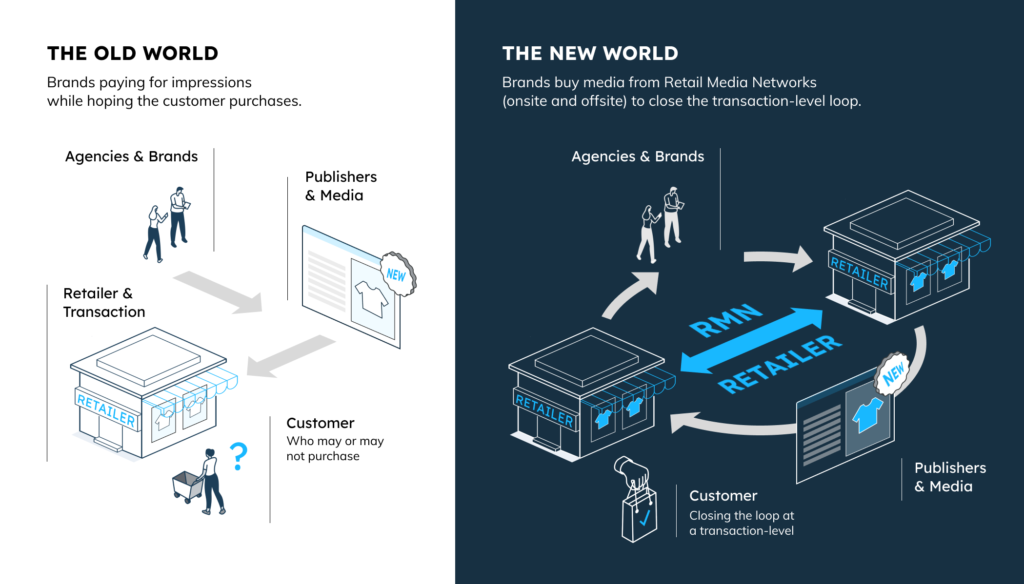With gross margins that can reach 70-90% — far exceeding other areas of retail — it’s no surprise that agencies and eCommerce brands are excited to take retail media to the next level with full funnel marketing services. By offering brand partners integrated advertising solutions that combine on and offsite placements and unify measurements, retailers can tap into budgets allocated to media, not only shopper marketing (or coop marketing). The retail media networks of eCommerce powerhouses like Albertsons, Amazon, and Walmart have already started to offer brand partners integrated, full funnel marketing capabilities.
“Commerce media” has even entered the lexicon. According to McKinsey, this term refers to a “new form of advertising that closes the loop between media impressions and commerce transactions to improve targeting, provide new audience insights, and deliver consumers more relevant and valuable experiences.”

Yet, the overall industry has a ways to go before it can achieve the promise of full funnel marketing. First, most retailers are afraid to annoy shoppers with irrelevant onsite ads. What makes retail media, so complex is that it has to serve three masters: shoppers, advertisers, and retailers. Although retailers still have a long way to go to get onsite right, numerous retail media solutions, including Crealytics Middleware, can help.
>>> Check out Crealytics Middleware
Regardless of the relative immaturity of most full funnel offerings, we believe the future is bright for integrated, top to bottom-funnel advertising solutions. Here’s why:
1. Increased organizational efficiency
When retailers offer an extensive portfolio of media products, they can combine retail media, coop advertising, and offline efforts. Removing these silos avoids disconnects and duplication of work, plus streamlines optimization and merges reporting. Now, the retailer can control the whole advertising supply chain.
2. Maximization of first party data
Advertisers turn to retail media networks because they can reach the retailers’ customers in a highly targeted way using retailers’ immense amount of first party consumer data. This advertising resource will become more and more valuable, particularly in light of privacy regulations like GDPR (General Data Protection) and the impending deprecation of cookies. At the same time, retailers face a strategic imperative – they must continuously discover and develop new media products that benefit from their first party data across the marketing funnel.
3. Alignment with omnichannel eCommerce
With eCommerce accounting for just over 13% of all U.S. retail sales at the end of last year (2021), it’s clear that scaling retail media networks demands an omnichannel approach.
By merging in-store with online data, retail media networks can help brands deliver seamless experiences to shoppers across environments, including consumers who still shop brick-and-mortar. Brands can now capitalize on in-aisle inventory to reach customers at both the virtual and physical point of purchase.
Retail media networks can further merge online and offline commerce by combining channels like display, search, and CTV (connected T.V.) with digital out-of-home media. To round out the omnichannel approach, retail media networks can sell inventory on mobile phones and in-store digital screens.
Retailers can track patterns to determine an omnichannel strategy’s effectiveness, then advise brands when it makes sense to work together to build top-of-the-funnel awareness or go for the bottom-of-funnel ad.
4. Stronger ROI and compliance through coop marketing
By bringing in coop marketing (short for cooperative marketing), brands can harness significantly more first party data through the retailer than if they were to engage customers independently. Consider these examples:
- Brand X uses coop dollars to retarget users on a retailer’s site who previously expressed an interest in their category.
- Brand Y uses coop to fund paid social ads that feature the brand’s product in the retailers’ Instagram.
With coop marketing, advertisers can deliver more personalized content without third party cookies while avoiding duplicate ad spending. Retailers who already have a solid offsite digital footprint (via social media and other paid channels) can offer better behavioral data across touchpoints within the customer journey — and charge their brand advertisers a premium.
5. Measurement and optimization of ad spend
Retailers can build full funnel advertising businesses by helping brand partners optimize digital ad spending with marketing insights and measurements. Albertsons’ audience and measurement solution with The Trade Desk and Walmart and Amazon’s API connections exemplify current features of retail media networks, allowing brands to dig deeper into marketing performance to iterate and optimize campaigns.
Access to campaign insights is particularly valuable, given current and growing privacy regulations that make visibility into marketing performance difficult. By relying on a retailer with consensual first party data of a shopper that it wants to reach, a brand can get the granular intelligence it needs without using third party cookies.
Last words
Retailers should open up their commerce media advertising opportunities to brands that encompass all stages of the marketing funnel, but only after they have mastered their site monetization offering at the point of purchase.
If you’re ready to drive the relevancy of your product listings to drive higher click-through rates, look to retail media solutions like Crealytics Middleware. The simple API integrates with your existing retail media vendor and uses no third party cookies, meaning it’s fully compliant with GDPR and other international privacy laws.
Want to learn more?





